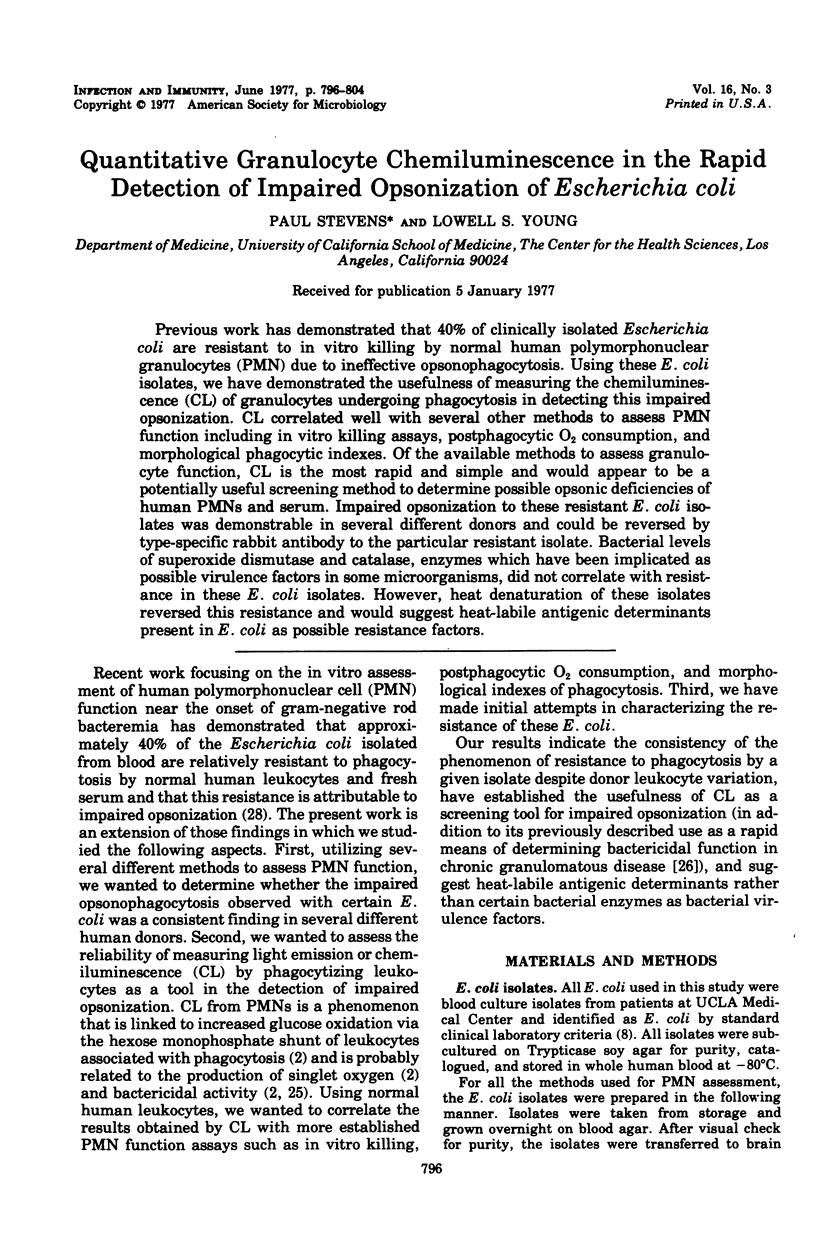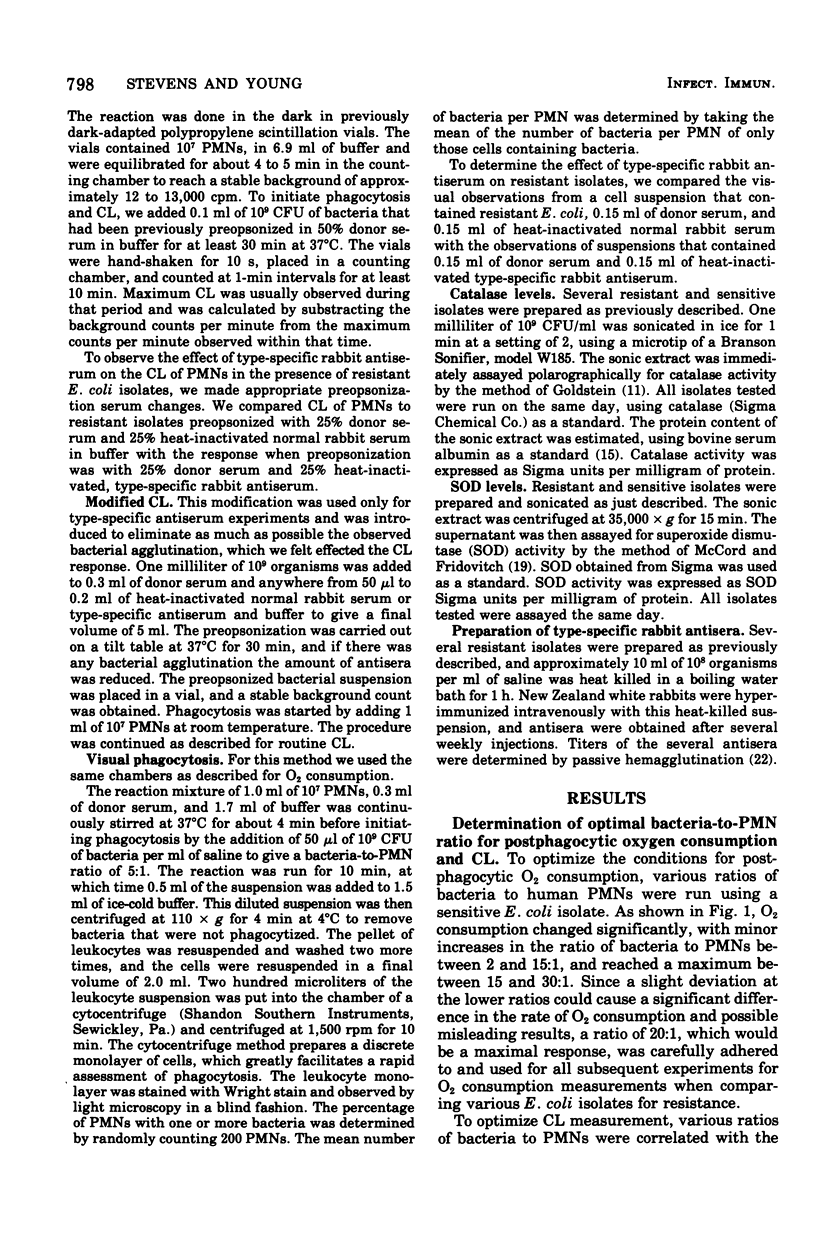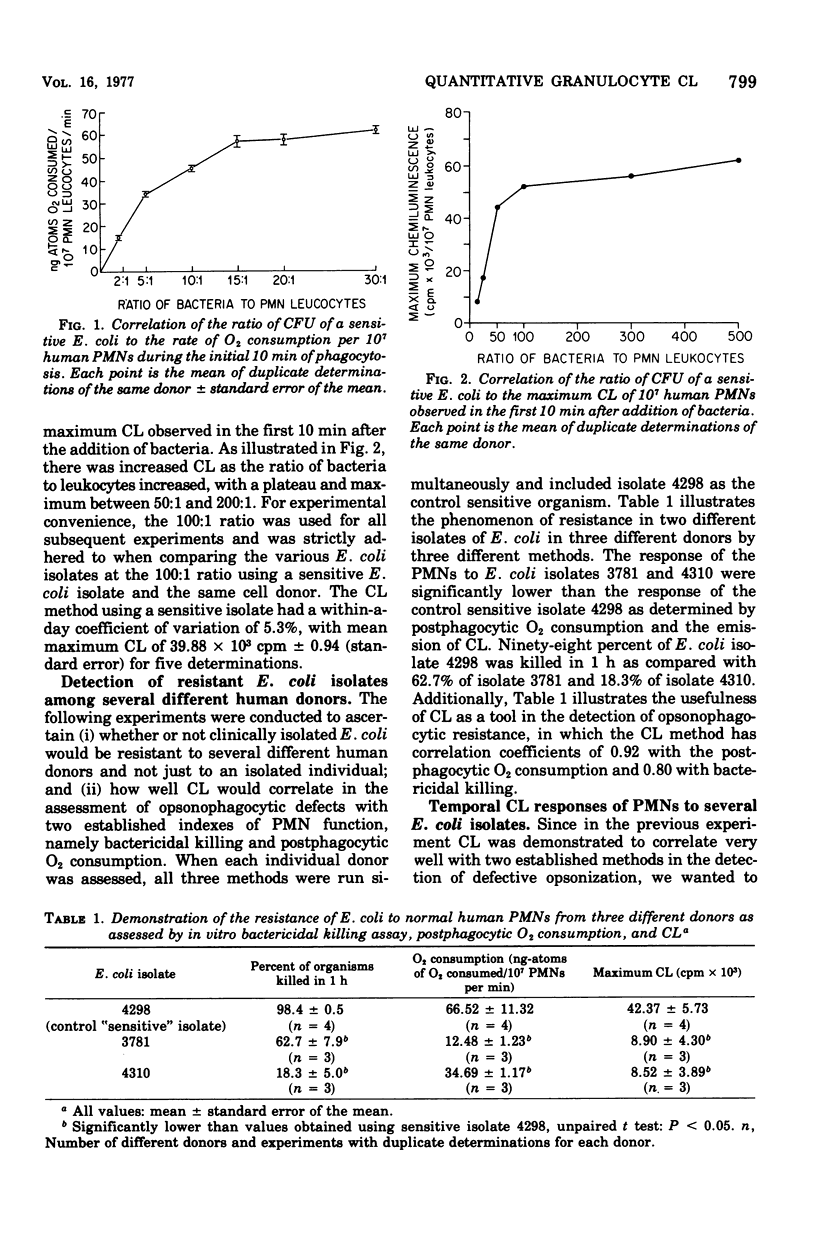Abstract
Previous work has demonstrated that 40% of clinically isolated Escherichia coli are resistant to in vitro killing by normal human polymorphonuclear granulocytes (PMN) due to ineffective opsonophagocytosis. Using these E. coli isolates, we have demonstrated the usefulness of measuring the chemiluminescence (CL) of granulocytes undergoing phagocytosis in detecting this impaired opsonization. CL correlated well with several other methods to assess PMN function including in vitro killing assays, postphagocytic O2 consumption, and morphological phagocytic indexes. Of the available methods to assess granulocyte function, CL is the most rapid and simple and would appear to be a potentially useful screening method to determine possible opsonic deficiencies of human PMNs and serum. Impaired opsonization to these resistant E. coli isolates was demonstrable in several different donors and could be reversed by type-specific rabbit antibody to the particular resistant isolate. Bacterial levels of superoxide dismutase and catalase, enzymes which have been implicated as possible virulence factors in some microorganisms, did not correlate with resistance in these E. coli isolates. However, heat denaturation of these isolates reversed this resistance and would suggest heat-labile antigenic determinants present in E. coli as possible resistance factors.
Full text
PDF








Selected References
These references are in PubMed. This may not be the complete list of references from this article.
- Allen R. C., Stjernholm R. L., Steele R. H. Evidence for the generation of an electronic excitation state(s) in human polymorphonuclear leukocytes and its participation in bactericidal activity. Biochem Biophys Res Commun. 1972 May 26;47(4):679–684. doi: 10.1016/0006-291x(72)90545-1. [DOI] [PubMed] [Google Scholar]
- Allen R. C. The role of PH in the chemiluminescent response of the myeloperoxidase-halide-HOOH antimicrobial system. Biochem Biophys Res Commun. 1975 Apr 7;63(3):684–691. doi: 10.1016/s0006-291x(75)80438-4. [DOI] [PubMed] [Google Scholar]
- Allen R. C., Yevich S. J., Orth R. W., Steele R. H. The superoxide anion and singlet molecular oxygen: their role in the microbicidal activity of the polymorphonuclear leukocyte. Biochem Biophys Res Commun. 1974 Oct 8;60(3):909–917. doi: 10.1016/0006-291x(74)90401-x. [DOI] [PubMed] [Google Scholar]
- Boyum A. Separation of blood leucocytes, granulocytes and lymphocytes. Tissue Antigens. 1974;4(4):269–274. [PubMed] [Google Scholar]
- Chappell J. B. The oxidation of citrate, isocitrate and cis-aconitate by isolated mitochondria. Biochem J. 1964 Feb;90(2):225–237. doi: 10.1042/bj0900225. [DOI] [PMC free article] [PubMed] [Google Scholar]
- Cheson B. D., Christensen R. L., Sperling R., Kohler B. E., Babior B. M. The origin of the chemiluminescence of phagocytosing granulocytes. J Clin Invest. 1976 Oct;58(4):789–796. doi: 10.1172/JCI108530. [DOI] [PMC free article] [PubMed] [Google Scholar]
- DeChatelet L. R., Mullikin D., Shirley P. S., McCall C. E. Phagocytosis of live versus heat-killed bacteria by human polymorphonuclear leukocytes. Infect Immun. 1974 Jul;10(1):25–29. doi: 10.1128/iai.10.1.25-29.1974. [DOI] [PMC free article] [PubMed] [Google Scholar]
- Goldstein D. B. A method for assay of catalase with the oxygen cathode. Anal Biochem. 1968 Sep;24(3):431–437. doi: 10.1016/0003-2697(68)90148-6. [DOI] [PubMed] [Google Scholar]
- Goldstein I. M., Roos D., Kaplan H. B., Weissmann G. Complement and immunoglobulins stimulate superoxide production by human leukocytes independently of phagocytosis. J Clin Invest. 1975 Nov;56(5):1155–1163. doi: 10.1172/JCI108191. [DOI] [PMC free article] [PubMed] [Google Scholar]
- Gregory E. M., Fridovich I. Oxygen toxicity and the superoxide dismutase. J Bacteriol. 1973 Jun;114(3):1193–1197. doi: 10.1128/jb.114.3.1193-1197.1973. [DOI] [PMC free article] [PubMed] [Google Scholar]
- Gregory E. M., Yost F. J., Jr, Fridovich I. Superoxide dismutases of Escherichia coli: intracellular localization and functions. J Bacteriol. 1973 Sep;115(3):987–991. doi: 10.1128/jb.115.3.987-991.1973. [DOI] [PMC free article] [PubMed] [Google Scholar]
- Howard C. J., Glynn A. A. The virulence for mice of strains of Escherichia coli related to the effects of K antigens on their resistance to phagocytosis and killing by complement. Immunology. 1971 May;20(5):767–777. [PMC free article] [PubMed] [Google Scholar]
- Lehrer R. I. Effects of colchicine and chloramphenicol on the oxidative metabolism and phagocytic activity of human neutrophils. J Infect Dis. 1973 Jan;127(1):40–48. doi: 10.1093/infdis/127.1.40. [DOI] [PubMed] [Google Scholar]
- Mandell G. L. Catalase, superoxide dismutase, and virulence of Staphylococcus aureus. In vitro and in vivo studies with emphasis on staphylococcal--leukocyte interaction. J Clin Invest. 1975 Mar;55(3):561–566. doi: 10.1172/JCI107963. [DOI] [PMC free article] [PubMed] [Google Scholar]
- Mandell G. L. Influence of type of ingested particle on human leukocyte metabolism. Proc Soc Exp Biol Med. 1971 Sep;137(4):1228–1230. doi: 10.3181/00379727-137-35761. [DOI] [PubMed] [Google Scholar]
- McCord J. M., Fridovich I. Superoxide dismutase. An enzymic function for erythrocuprein (hemocuprein). J Biol Chem. 1969 Nov 25;244(22):6049–6055. [PubMed] [Google Scholar]
- NETER E., BERTRAM L. F., ZAK D. A., MURDOCK M. R., ARBESMAN C. E. Studies on hemagglutination and hemolysis by escherichia coli antisera. J Exp Med. 1952 Jul;96(1):1–15. doi: 10.1084/jem.96.1.1. [DOI] [PMC free article] [PubMed] [Google Scholar]
- Peterson P. K., Verhoef J., Sabath L. D., Quie P. G. Extracellular and bacterial factors influencing staphylococcal phagocytosis and killing by human polymorphonuclear leukocytes. Infect Immun. 1976 Aug;14(2):496–501. doi: 10.1128/iai.14.2.496-501.1976. [DOI] [PMC free article] [PubMed] [Google Scholar]
- Root R. K., Metcalf J., Oshino N., Chance B. H2O2 release from human granulocytes during phagocytosis. I. Documentation, quantitation, and some regulating factors. J Clin Invest. 1975 May;55(5):945–955. doi: 10.1172/JCI108024. [DOI] [PMC free article] [PubMed] [Google Scholar]
- Rosen H., Klebanoff S. J. Chemiluminescence and superoxide production by myeloperoxidase-deficient leukocytes. J Clin Invest. 1976 Jul;58(1):50–60. doi: 10.1172/JCI108458. [DOI] [PMC free article] [PubMed] [Google Scholar]
- Stjernholm R. L., Allen R. C., Steele R. H., Waring W. W., Harris J. A. Impaired chemiluminescence during phagocytosis of opsonized bacteria. Infect Immun. 1973 Feb;7(2):313–314. doi: 10.1128/iai.7.2.313-314.1973. [DOI] [PMC free article] [PubMed] [Google Scholar]
- WOOD W. B., Jr Studies on the cellular immunology of acute bacterial infections. Harvey Lect. 1951;Series 47:72–98. [PubMed] [Google Scholar]
- Webb L. S., Keele B. B., Jr, Johnston R. B., Jr Inhibition of phagocytosis-associated chemiluminescence by superoxide dismutase. Infect Immun. 1974 Jun;9(6):1051–1056. doi: 10.1128/iai.9.6.1051-1056.1974. [DOI] [PMC free article] [PubMed] [Google Scholar]
- Weinstein R. J., Young L. S. Neutrophil function in gram-negative rod bacteremia. The interaction between phagocytic cells, infecting organisms, and humoral factors. J Clin Invest. 1976 Jul;58(1):190–199. doi: 10.1172/JCI108449. [DOI] [PMC free article] [PubMed] [Google Scholar]
- Yost F. J., Jr, Fridovich I. Superoxide radicals and phagocytosis. Arch Biochem Biophys. 1974 Apr 2;161(2):395–401. doi: 10.1016/0003-9861(74)90320-8. [DOI] [PubMed] [Google Scholar]


